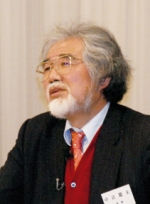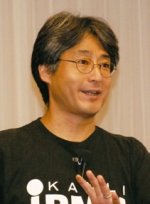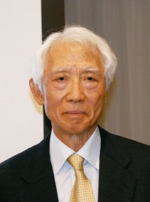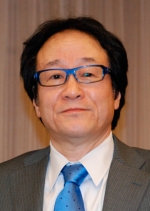December 18, 2013
The 128th
"Application of Human Pluripotent Stem Cells for Regenerative Medicine and Drug Discovery"
─Global Status and Technology Development for Practical Application"
December 18, 2013 at Tokyo Kaikan
"Application of Human Pluripotent Stem Cells for Regenerative Medicine and Drug Discovery"
─Global Status and Technology Development for Practical Application"
December 18, 2013 at Tokyo Kaikan
Dr. Nakatsuji is the first Japanese to succeed in establishing the human embryonic stem cell, one of the human pluripotent stem cells, and build a distribution network. Expectations of human pluripotent stem cells are high because they have the pluripotentiality to differentiate into various cells and the ability to proliferate limitlessly. R&D is proceeding worldwide on applications in medicine and drug development.
However, Dr. Nakatsuji is against having too optimistic a view and pointed to difficulties in practical use. This is because there are lots of challenges to solve first, including developing a robust and reliable production method. He also introduced some technological developments that may find solutions to these challenges. Dr. Nakatsuji explained misinterpretation and simplification about embryonic stem cell in Japanese society, and warned that an ability to grasp its strengths and weakness are essential if Japan is to take the lead in this field.
Participants who had hoped for practical use in the near future were surprised at how wrong information in the media has been and at the actual situation. Today's lecture not only changed people's understanding but also raised expectations for Japan as a leader in this field from now.
However, Dr. Nakatsuji is against having too optimistic a view and pointed to difficulties in practical use. This is because there are lots of challenges to solve first, including developing a robust and reliable production method. He also introduced some technological developments that may find solutions to these challenges. Dr. Nakatsuji explained misinterpretation and simplification about embryonic stem cell in Japanese society, and warned that an ability to grasp its strengths and weakness are essential if Japan is to take the lead in this field.
Participants who had hoped for practical use in the near future were surprised at how wrong information in the media has been and at the actual situation. Today's lecture not only changed people's understanding but also raised expectations for Japan as a leader in this field from now.
Dr. Norio Nakatsuji
Professor and Founding Director, Institute for Integrated Cell-Material Sciences, Kyoto University
Professor and Founding Director, Institute for Integrated Cell-Material Sciences, Kyoto University

August 29, 2013
The 127th
"Wrinkles and Seeds of the Universe"
August 29, 2013 at Tokyo Kaikan
"Wrinkles and Seeds of the Universe"
August 29, 2013 at Tokyo Kaikan
As director of the Kavli Institute for the Physics and Mathematics of the Universe (Kavli IPMU) since 2007, Dr. Murayama ranks among the leading researchers in physics, specializing in fields of elementary particles and the early Universe. He has attracted worldwide attention with his initiative in the SuMIRe Project with the National Astronomical Observatory's Subaru Telescope and his efforts to explore the origins of the Universe with innovative observations of outer space with wide-field imaging and the prime focus spectrograph (PFS).
He spoke of how he was inspired to pursue space research, referring to the simple questions he had as a child, looking at the night sky, regarding how the Universe began and why the human race was born. Using research achievements, he explained the theory of how a Universe that was smaller than a single atom expanded explosively over a distance of 1.38 billion light years and how the "wrinkles" that were created in the process attracted the mysterious dark material to create stars and form galaxies.
His very casual manner of explaining the complex theories of astrophysics in simple and easy terms for beginners was very well received, sometimes drawing laughter from the audience.
He spoke of how he was inspired to pursue space research, referring to the simple questions he had as a child, looking at the night sky, regarding how the Universe began and why the human race was born. Using research achievements, he explained the theory of how a Universe that was smaller than a single atom expanded explosively over a distance of 1.38 billion light years and how the "wrinkles" that were created in the process attracted the mysterious dark material to create stars and form galaxies.
His very casual manner of explaining the complex theories of astrophysics in simple and easy terms for beginners was very well received, sometimes drawing laughter from the audience.
Dr. Hitoshi Murayama
Director, Kavli Institute for the Physics and Mathematics of the Universe,
The University of Tokyo
Director, Kavli Institute for the Physics and Mathematics of the Universe,
The University of Tokyo

June 14, 2013
The 126th
"Fusion Energy" —Progress in the Development of Our Future Energy Source by International Collaborations
June 14, 2013 at Tokyo Kaikan
"Fusion Energy" —Progress in the Development of Our Future Energy Source by International Collaborations
June 14, 2013 at Tokyo Kaikan
Dr. Seki is a prominent authority on thermal engineering in the field of nuclear fusion research who has made extensive contributions to the engineering design completion of ITER, an international collaboration project in nuclear fusion research and engineering. Nuclear fusion is a field of research aimed at "creating the Sun on Earth," founded on the principles of solar power radiation. R&D is underway through collaboration between Japan, the EU, the US and other nations.
Dr. Seki began his presentation from the elementary theory of nuclear fusion and described the progress Japan has made in nuclear fusion experiments. Founded on such information, he reported on the important role Japan is playing in the ITER project. An experimental reactor is scheduled to be built in Cadarache, France, starting in 2015 but the project
is still in the phase of examining the scientific and technical feasibility, and deliberations on practical operation is believed to be premature.
To participants who expressed concerns over nuclear power development itself in view of the Fukushima Daiichi Nuclear Power Plant accident in 2011, Dr. Seki spoke of the importance of continuing to examine nuclear safety and holding deliberations on the direction nuclear power development should take.
Dr. Seki began his presentation from the elementary theory of nuclear fusion and described the progress Japan has made in nuclear fusion experiments. Founded on such information, he reported on the important role Japan is playing in the ITER project. An experimental reactor is scheduled to be built in Cadarache, France, starting in 2015 but the project
is still in the phase of examining the scientific and technical feasibility, and deliberations on practical operation is believed to be premature.
To participants who expressed concerns over nuclear power development itself in view of the Fukushima Daiichi Nuclear Power Plant accident in 2011, Dr. Seki spoke of the importance of continuing to examine nuclear safety and holding deliberations on the direction nuclear power development should take.
Dr. Masahiro Seki
President, Research Organization for Information Science and Technology (RIST)
President, Research Organization for Information Science and Technology (RIST)

March 13, 2013
The 125th
"Nanophotonics" ─The Way to See Nano with Light
March 13, 2013 at Tokyo Kaikan
"Nanophotonics" ─The Way to See Nano with Light
March 13, 2013 at Tokyo Kaikan
You are called a heretic or illusionist when you think what most don't and advocate eccentric ideas. But I have done my research in the belief that, to create something new, you must dare to try seemingly reckless things because you can possibly change today's nonsense into tomorrow's common sense. My dream to see the nanoworld with light was eccentric too, for the wavelengths of molecules are 1000 times shorter than that of light. After many years of trial and error, we successfully developed a microscope capable of viewing nanostructures by shortening the wavelength of light using the phenomenon called 'plazmon' where free electrons collectively oscillate in a metal. The combination of plazmon and photonics has spawned a new study field called 'plazmonics.' In addition to the observation and processing of nanomaterials, plazmonics can be used for the development of highly-efficient light source and laser, and of new materials. Likewise we have developed a technology to create three-dimensional nanostructures by use of the two-photon absorption phenomenon induced by near-infrared light. This technology would not only enable the production of petabyte optical disks, but facilitate the development of medical micromachines that work within the bodies of patients. In 2005 we started a company that makes and sells nanophoton microscopes and other instruments with the aim of contributing to the society through development of able human resources and new industries derived from our studies.
Dr. Satoshi Kawata
Professor of Applied Physics at Osaka University
Professor of Applied Physics at Osaka University







